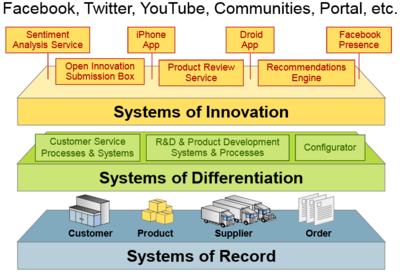Gartner's PACE Layered Application Strategy
PACE Layered Application Strategy Definition
PACE Layered Application Strategy is a methodology to govern software applications through their entire life-cycle in support of evolving business requirements. Pace layered approach has been developed by the advisory firm Gartner.
Gartner Pace layered application strategy

Pace Layered thinking has four salient features:
- Governance Framework: The focus is on better IT decisions - higher business value at a lower cost, and risk
- Application Life Cycle: These decisions are along the entire application lifecycle - identify, select, fund, build, deploy, operate, and sunset
- Application Portfolio: The decisions are common across a group of applications...
- Application Layers: ...that fit into a category or "layer" which contains applications with similar characteristics requiring similar governance approach
- Evolving Business Requirements: The objective is to adapt the application portfolio driven by changing business needs for maximum business value
Pace layer thinking takes a more granular approach to business applications in a portfolio - does this application support a common requirement, a unique business methodology or an innovative new business process? This allows the organization to apply the appropriate governance, funding and data models, based on the characteristics of each application.
Pace layers force the categorization of applications by process or function rather than the more common cross-process package (ERP, CRM etc.) classification used in the enterprise. For example, financial accounting, order entry and collaborative demand planning are often part of a single ERP package, but are separate application modules that belong in three different layers in the Pace-Layered Application Strategy. [1]
Gartner defines pace layered approach as follows:
Gartner’s Pace-Layered Application Strategy is a methodology for categorizing, selecting, managing and governing applications to support business change, differentiation and innovation.[2]
Application Layers
Gartner postulates that there are different layers of software applications in an organization. Each layer contains applications with common characteristics related to the speed of adaptation, and change. Therefore, governance requirements are different between layers but applications in each layer can be governed similarly.
Gartner has defined three application categories, or "layers," to distinguish application types and help organizations develop more appropriate strategies for each:[3]
- Systems of Record — Established packaged applications or legacy homegrown systems that support core transaction processing and manage the organization's critical master data. The rate of change is low, because the processes are well-established and common to most organizations, and often are subject to regulatory requirements.
- Systems of Differentiation — Applications that enable unique company processes or industry-specific capabilities. They have a medium life cycle (one to three years), but need to be reconfigured frequently to accommodate changing business practices or customer requirements.
- Systems of Innovation — New applications that are built on an ad hoc basis to address new business requirements or opportunities. These are typically short life cycle projects (zero to 12 months) using departmental or outside resources and consumer-grade technologies.
Business Innovation
Gartner claims that adopting a Pace-Layered Application Strategy can build a business application strategy that accelerates innovation - faster response, and better ROI, without sacrificing integration, integrity and/or governance.
Pace Layering, and Shearing Layers
Pace layering is a concept built upon the shearing layers concept coined by architect Frank Duffy, and elaborated by Stewart Brand in his book, How Buildings Learn: What Happens After They’re Built (Brand, 1994).
Pace Governance

Source: Data Chatter Box
Pace Layered Architecture

Source: Data Chatter Box
See Also
References

